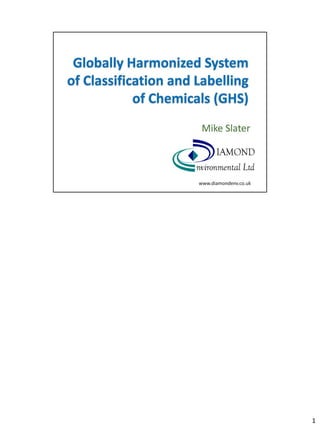
Developing a universal hazardous substance labeling system
- 1. 1
- 2. An attempt to develop a universal system for labeling hazardous substances and preparations The UN GHS is not a formal treaty, but instead is a non-legally binding international agreement. Therefore countries (or trading blocks, like the European Union) must establish legislation for their jurisdiction in order to implement the UN GHS. 2
- 3. The GHS is being implemented in the EU via the Regulation on Classification, Labelling and Packaging of Substances and Mixtures (known as the CLP Regulation). The CLP isn’t only about labelling. As it’s name makes clear, there are also requirements relating to how the substances are packaged. As a Regulation, it is directly-acting in all EU Member States, requiring no national transposition. Its provisions will be phased in over a period of years until 1 June 2015 when the Regulation will be fully in force. 3
- 4. The new labelling requirements have some similarities, but a number of differences, to the those we’re used to in Europe. Labels on the packaging of hazardous substances and preparations (i.e. mixtures of chemicals) will still have to show pictograms which summarise the key hazards, but they will look different 4
- 5. New pictograms are introduced that replace the old CHIP orange rectangles Most of the symbols used are the same, although there are some new ones 5
- 6. The format of the pictograms is based on those currently used for the transport of Dangerous Goods under the “Accord européen relatif au transport international des marchandises dangereuses par route”, known as ADR, which implemented another UN agreement in Europe 6
- 7. 7
- 8. Explosion 8
- 9. Flammable substances 9
- 10. Oxidising agents 10
- 11. Looks like a cricket bat to me! 11
- 12. For compressed gases 12
- 13. 13
- 14. Corrosive 14
- 15. Acute toxicity (Classes 1 to 3) The familiar terms “very toxic” and “toxic” will no longer be used. Instead Hazard categories are applied – the lower the category the more hazardous the material 15
- 16. The familiar St Andrews cross will be replaced by the new “exclamation mark symbol”. It will be applied to irritant substances and category 4 acute toxicity. However, some substances currently carrying the cross will have to show the new “skull and crossbones” symbol due to new rules on classification. 16
- 17. I think many people will find this confusing. It doesn’t have an obvious meaning. 17
- 18. This new pictogram is applied to substances that present serious longer term health hazards such as carcinogens and respiratory sensitisers 18
- 19. 19
- 20. Hazardous to the aquatic environment 20
- 21. For each type of hazard there are a number of hazard categories The number of hazard categories varies depending on the hazard The lower the number, the greater the hazard 21
- 22. New criteria are introduced for assigning the hazard class. This is likely to have some significant implications for suppliers as there are some significant differences between the system used under CHIP and the new CLP Annex VII of the CLP Regulation presents a ‘translation’ table which can be used to ‘convert’ classifications made under the current Dangerous Substances Directive to the new classifications made by applying the CLP criteria. Where there is no direct one-to-one equivalent, the Annex has assigned the least severe classification and places a duty on the supplier to decide if a more severe classification is needed. This annex is intended to be used by those substances and mixtures that have already been self-classified under the existing European legislation, and where the hazard categories identified are equivalent. 22
- 23. One of these two signal words will have to be printed on the label. In effect they take the place of the CHIP hazard category statements (e.g. Toxic, Irritant, Corrosive etc.) Which signal word is used depends on the hazard category 23
- 24. 24
- 25. 25
- 26. The numbering of the hazard statements depends on the type of hazard while for the precautionary statements it depends on the type of measure 26
- 27. CHIP Label 27
- 28. GHS Label for the same substance 28
- 29. Sometimes labels may also include information required under the ADR (i.e. for transport) 29
- 30. There are no plans to provided any guidance on CLP at UK level. The HSE refers chemical suppliers (and anyone else who want more information) to the European Chemicals Agency (ECHA) guidance available at http://echa.europa.eu/clp/clp_help_en.asp. 30
- 31. Manufacturers and importers need to notify ECHA by 3 January 2011 of the classification of substances placed on the market that are: - subject to REACH Registration (for substances to be registered by 30 November 2010, notification will be part of the registration dossier); - classified as hazardous (regardless of volume) - in mixtures above certain concentration limits, which result in the need for classification. 31
- 32. 32
